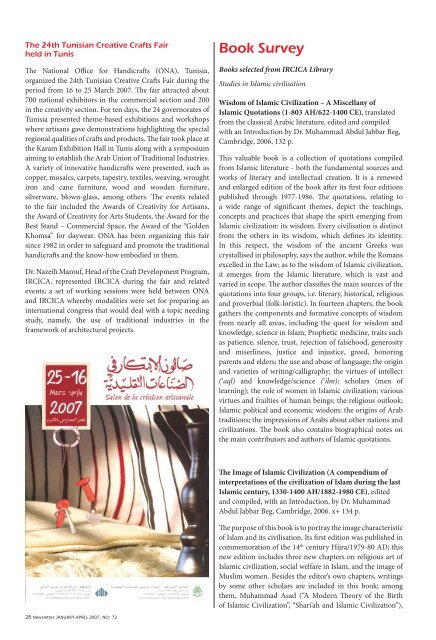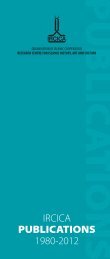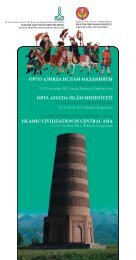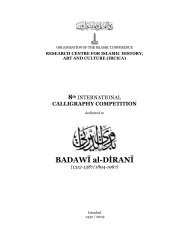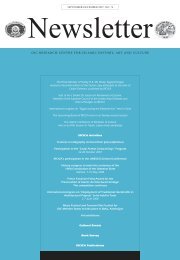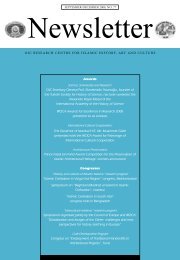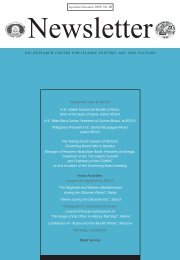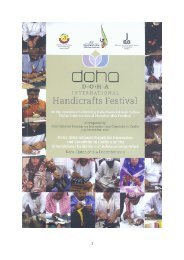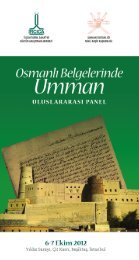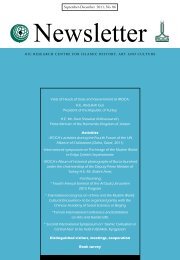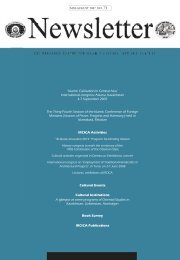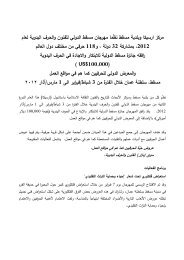The 24th Tunisian Creative Crafts Fairheld in TunisThe National Office for Handicrafts (ONA), Tunisia,organized the 24th Tunisian Creative Crafts Fair during theperiod from 16 to 25 March 2007. The fair attracted about700 national exhibitors in the commercial section and 200in the creativity section. For ten days, the 24 governorates ofTunisia presented theme-based exhibitions and workshopswhere artisans gave demonstrations highlighting the specialregional qualities of crafts and products. The fair took place atthe Karam Exhibition Hall in Tunis along with a symposiumaiming to establish the Arab Union of Traditional Industries.A variety of innovative handicrafts were presented, such ascopper, mosaics, carpets, tapestry, textiles, weaving, wroughtiron and cane furniture, wood and wooden furniture,silverware, blown-glass, among others. The events relatedto the fair included the Awards of Creativity for Artisans,the Award of Creativity for Arts Students, the Award for theBest Stand – Commercial Space, the Award of the “GoldenKhomsa” for daywear. ONA has been organizing this fairsince 1982 in order to safeguard and promote the traditionalhandicrafts and the know-how embodied in them.Dr. Nazeih Marouf, Head of the Craft Development Program,<strong>IRCICA</strong>, represented <strong>IRCICA</strong> during the fair and relatedevents; a set of working sessions were held between ONAand <strong>IRCICA</strong> whereby modalities were set for preparing aninternational congress that would deal with a topic needingstudy, namely, the use of traditional industries in theframework of architectural projects.Book SurveyBooks selected from <strong>IRCICA</strong> LibraryStudies in Islamic civilisationWisdom of Islamic Civilization – A Miscellany ofIslamic Quotations (1-803 AH/622-1400 CE), translatedfrom the classical Arabic literature, edited and compiledwith an Introduction by Dr. Muhammad Abdul Jabbar Beg,Cambridge, 2006, 132 p.This valuable book is a collection of quotations compiledfrom Islamic literature - both the fundamental sources andworks of literary and intellectual creation. It is a renewedand enlarged edition of the book after its first four editionspublished through 1977-1986. The quotations, relating toa wide range of significant themes, depict the teachings,concepts and practices that shape the spirit emerging fromIslamic civilization: its wisdom. Every civilisation is distinctfrom the others in its wisdom, which defines its identity.In this respect, the wisdom of the ancient Greeks wascrystallised in philosophy, says the author, while the Romansexcelled in the Law; as to the wisdom of Islamic civilization,it emerges from the Islamic literature, which is vast andvaried in scope. The author classifies the main sources of thequotations into four groups, i.e. literary, historical, religiousand proverbial (folk-loristic). In fourteen chapters, the bookgathers the components and formative concepts of wisdomfrom nearly all areas, including the quest for wisdom andknowledge, science in Islam, Prophetic medicine, traits suchas patience, silence, trust, rejection of falsehood, generosityand miserliness, justice and injustice, greed, honoringparents and elders; the use and abuse of language; the originand varieties of writing/calligraphy; the virtues of intellect(‘aql) and knowledge/science (‘ilm); scholars (men oflearning); the role of women in Islamic civilization; variousvirtues and frailties of human beings; the religious outlook;Islamic political and economic wisdom; the origins of Arabtraditions; the impressions of Arabs about other nations andcivilizations. The book also contains biographical notes onthe main contributors and authors of Islamic quotations.The Image of Islamic Civilization (A compendium ofinterpretations of the civilization of Islam during the lastIslamic century, 1330-1400 AH/1882-1980 CE), editedand compiled, with an Introduction, by Dr. MuhammadAbdul Jabbar Beg, Cambridge, 2006. x+ 134 p.The purpose of this book is to portray the image characteristicof Islam and its civilisation. Its first edition was published incommemoration of the 14 th century Hijra/1979-80 AD; thisnew edition includes three new chapters on religious art ofIslamic civilization, social welfare in Islam, and the image ofMuslim women. Besides the editor’s own chapters, writingsby some other scholars are included in this book; amongthem, Muhammad Asad (“A Modern Theory of the Birthof Islamic Civilization”, “Shari’ah and Islamic Civilization”),26 <strong>Newsletter</strong> JANUARY-APRIL 2007, NO: <strong>72</strong>
H.A.R. Gibb and Costi K. Zurayk (“The Matrices of IslamicCivilisation”), W.H. McNeil and T. Izutsu et al. (“Islam: TheHallmark of A Civilisation”), Zeki Velidi Togan (“Al-Qur’anand its Influence”), Richard Ettinghausen and M.A.J. Beg etal. (“Islamic Art and Civilisation”) with excerpts from SeyyedHussein Nasr, Thomas Irving, Arnold J. Toynbee, amongothers. This highly instructive book is further enriched bydiscussions of some topics seldom treated elsewhere, suchas “race and colour in Islam”, together with overviews ofthe development of the city, arts, sciences, etc. in Islamiccivilisation.Dr. Muhammad Abdul Jabbar Beg, Essays on the Originsof Islamic Civilization, Cambridge, 2006, vii + 312 p.The essays in this book formed part of the author’sintroductory lectures on Islamic Civilization at the NationalUniversity of Malaysia from 1977 onward. The author firstcritically evaluates the view that Islam had its origins inJudaism and Christianity. He also focuses on the origins ofthe Islamic state with particular reference to the constitutionof Madinah. The book also treats the following topics: anevaluation of social gradation or stratification in early Islamicsociety; the role of women during the first Islamic century(their functions in warfare, economy and as propagatorsof traditions, etc.); labour and craftsmanship in earlyIslamic society; the establishment of garrison towns and itscontribution to the foundation of new places of worship; theorigins of Islamic art and architecture, the origins of Islamicscience. Under each theme the author refers to the pertinentdebates and literature, thus depicting the state of the artand providing bibliographical information. This is anothervaluable book in the series of well-chosen, well-documentedthemes edited by Dr. Muhammad Abdul Jabbar Beg on Islam,Islamic civilization and the Muslim world.ArtsFine Arts of Islamic Civilization (A Collection of Essaysby Art Historians), Edited with and Introduction by Dr.Muhammad Abdul Jabbar Beg, Cambridge 2006, v+180 p.This collection of articles is not only a rich reference onthe fine arts and architecture in Islam, but it also discussesextensively and presents ample materials on issues ofparticular relevance in the study of Islamic arts such asthe controversy on portraiture (taswir, representation).Topics covered include Al-Ghazzali’s perception of beautymainly as reflected in his work Kimiya-i Sa’adat (Alchemy ofHappiness); different kinds of religious music in Islam as seenin the “reading” of the Qur’an, the adhan (call to prayer) andthe music of the Sufi orders; architecture in Islam, the conceptof space, fine arts in architecture, etc.; an examination ofIslamic motifs in Spanish and Latin-American architecture;religious arts of Islam such as arabesque, geometric art andcalligraphy. Wherever possible and relevant, the authordraws comparisons with Christian and Jewish perspectiveson the issues covered.Abdallah Attiya, Al-Athar wa’l funun al-Islamiya (Islamicartifacts and arts), el-Nahda el-Misriya, Cairo, 2007 (inArabic)This book traces the evolution of Islamic arts from theearly centuries of Islam onwards in with reference to majorIslamic cities, architectural structures and complexes such asmedreses, hospitals, baths, fountains, mosques and citadels;applied arts; urban development; the different epochs andstyles such as the Omeyad, the Timurid, the Seljukid, theOttoman periods, Iranian arts and architecture, etc. all basedon descriptions of representative monuments. Maps, plansand photographs enrich the book. The author has completedhis postgraduate studies in art history at Istanbul University.Abdallah Attiya, Dirasat fi al-fen al-Turki (Studies inTurkish art), el-Nahda el-Misriya, Cairo, 2007 (in Arabic,introduction in Turkish)The first part of this book is a comprehensive overview of thearts of ornamented tiles, metal works, carpets, textiles andwoodwork within the context of Turkish arts, particularlyduring the period of the Seljuk and Ottoman states. Thesecond part studies selected monuments dating from theOttoman period in Turkey and Egypt with regard to theirdecorations and other artistic elements: Yeşil Türbe (GreenTomb) in Bursa, Sirçali Medrese in Konya. In this part, theauthor also examines examples of structures built in Istanbulby some Ottoman governors of Egypt such as Koca SinanPasha, Mehmet Mesih Pasha, Husrev Pasha some of whichreflect the influence of Mamluk art. Other sections in thebook are related to: early Ottoman mosques in Istanbul,European influences on Istanbul mosques of the 18 th and 19 thcenturies, and finally, Sidi Mihriz Mosque in Tunis, which,the author indicates, is the only mosque of Tunis built in theOttoman style, during the Ottoman period; its qibla wallis covered with tiles produced in Tunis on the example ofOttoman tiles.History of science and technologySalim Aydüz, Tophâne-i Âmire ve Top Döküm Teknolojisi(The Imperial Cannon Foundry and the technology ofcannon casting), published by the Turkish HistoricalSociety, Ankara, 2006, xxiii+559 p.On the basis of original sources, the author examines theOttoman contributions in the field of firearms and militarytechnology. The book covers the period starting from theestablishment of the Imperial Cannon Foundry (Tophane-iÂmire) until the end of the 16 th century when the Ottomanarmies began to weaken in the face of powerful Europeanarmies. This scholarly work is an expanded and revisedversion of the Ph D dissertation prepared by the authorunder the supervision of Prof. Ekmeleddin İhsanoğlu in1998. It was completed within the framework of the scientificprojects on Ottoman contacts with Western technologywhich were carried out with the cooperation of <strong>IRCICA</strong> andJANUARY-APRIL 2007, NO: <strong>72</strong> <strong>Newsletter</strong> 27


